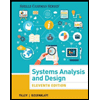
Business Driven Technology
7th Edition
ISBN: 9781259567322
Author: Paige Baltzan Instructor
Publisher: McGraw-Hill Education
expand_more
expand_more
format_list_bulleted
Concept explainers
Question
Chapter 17, Problem 2CQ
Program Plan Intro
Business Requirements:
- The specific business requests system should meet so as to be successful.
- The entire system development effort is driven by business requirements.
- The business requirements are gathered through investigation.
- The users identify all business needs of organization and take measurements for these needs.
- The methods to gather requirements includes:
- Conducting user interviews to determine current issues and operations.
- Surveying employees through questionnaires for discovering issues.
- Making observations to determine manner in which current operations are been performed.
- Reviewing business documents for discovering policies, reports and how information is been used in organization.
Ambiguous Business Requirements:
- An ambiguous requirement means that multiple readers may interpret the same thing in different ways.
- It may rise due to inadequate participation of end users during design and analysis phases.
- It may occur commonly in reports due to different mindset of developers and users.
Expert Solution & Answer
Want to see the full answer?
Check out a sample textbook solution
Students have asked these similar questions
using r language
Write a function to compute a Monte Carlo estimate of the Beta(3,
3) cdf, and use the function to estimate F(x) for x = 0.1,0.2,...,0.9.
Compare the estimates with the values returned by the pbeta function
in R.
Write a function to compute a Monte Carlo estimate of the Gamma(r = 3, λ = 2) cdf, and use the function to estimate F(x) for x = 0.2, 0.4, . . . , 2.0. Compare the estimates with the values returned by the pgamma function in R.
Knowledge Booster
Learn more about
Need a deep-dive on the concept behind this application? Look no further. Learn more about this topic, computer-science and related others by exploring similar questions and additional content below.Similar questions
- using r languagearrow_forwardusing r languagearrow_forwardYou are given a class that processes purchases for an online store. The class receives calls to: • Retrieve the prices for items from a database • Record the sold items • Update the database • Refresh the webpage a. What architectural pattern is suitable for this scenario? Illustrate your answer by drawing a model for the solution, showing the method calls/events. b. Comment on how applying this pattern will impact the modifiability of the system. c. Draw a sequence diagram for the update operation.arrow_forward
- The images I have uploaded are the part 1 to 4 and questions below are continue on the questions uploaded 5. C++ Class Template with Method Stubs #pragma once #include <iostream> #include <string> #include <stdexcept> #include <vector> template <typename T> class HashTable { private: struct Entry { std::string key; T value; bool isOccupied; bool isDeleted; Entry() : key(""), value(), isOccupied(false), isDeleted(false) {} }; Entry* table; size_t capacity; size_t size; double loadFactorThreshold; size_t customHash(const std::string& key) const { size_t hash = 5381; for (char c : key) { hash = ((hash << 5) + hash) + c; } return hash; } size_t probe(const std::string& key, bool forInsert = false) const; void resize(); public: // Constructor HashTable(size_t initialCapacity = 101); // Big…arrow_forwardthis project is NOT for graded(marks) purposes, please help me with the introduction. give me answers for the project. i will include an image explaining everything about the project.arrow_forwardJava Graphics (Bonus In this lab, we'll be practicing what we learned about GUIs, and Mouse events. You will need to implement the following: A GUI with a drawing panel. We can click in this panel, and you will capture those clicks as a Point (see java.awt.Point) in a PointCollection class (you need to build this). The points need to be represented by circles. Below the drawing panel, you will need 5 buttons: O о о ○ An input button to register your mouse to the drawing panel. A show button to paint the points in your collection on the drawing panel. A button to shift all the points to the left by 50 pixels. The x position of the points is not allowed to go below zero. Another button to shift all the points to the right 50 pixels. " The x position of the points cannot go further than the You can implement this GUI in any way you choose. I suggest using the BorderLayout for a panel containing the buttons, and a GridLayout to hold the drawing panel and button panels. Regardless of how…arrow_forward
- also provide the number of moves(actions) made at state A and moves(actions) made state B. INCLUDE Java program required(this question is not graded)arrow_forwardYou are given a class that processes purchases for an online store. The class receives calls to: • Retrieve the prices for items from a database • Record the sold items • Update the database • Refresh the webpage a. What architectural pattern is suitable for this scenario? Illustrate your answer by drawing a model for the solution, showing the method calls/events. b. Comment on how applying this pattern will impact the modifiability of the system. c. Draw a sequence diagram for the update operation.arrow_forward2. The memory management has contiguous memory allocation, dynamic partitions, and paging. Compare the internal fragmentation and external fragmentation for these three approaches. [2 marks] 3. Suppose we have Logical address space = 24 = 16 (m = 4), Page size=2² =4 (n = 2), Physical address space = 26 = 64 (r = 6). Answer the following questions: [4 marks] 1) Total # of pages ? 2) Total # of frames ? 3) Number of bits to represent logical address? 4) Number of bits to represent offset ? 5) Number of bits to represent physical address? 6) Number of bits to represent a page number? 7) Number of bits to represent a frame number / 4. What is translation look-aside buffers (TLBS)? Why we need them to implement the page table? [2 marks] 5. Why we need shared pages for multiple processes? Give one example to show the benefits. [2 marks] 6. How to implement the virtual memory by using page out and page in? Explain with an example. [2 marks] 7. We have a reference string of referenced page…arrow_forward
- Good morning, please solve this trying to follow this criteria. (use Keil) Abstract describing the requirements and goals of the assignment. List file with no errors or warnings. Brief description of your implementation design and code. Debugging screen shots for different scenarios with your reference and comments. Conclusion (and please give me the code without errors, make sure it is working)arrow_forwardGood mrng, please solve this trying to follow this criteria. (use Keil) Abstract describing the requirements and goals of the assignment. List file with no errors or warnings. Brief description of your implementation design and code. Debugging screen shots for different scenarios with your reference and comments. Conclusion (and please give me the code without errors, make sure it is working)arrow_forward#include <stdio.h> #include <stdlib.h> #include <unistd.h> int global_var = 42; // int* function(int *a) { int local_var = 10; // *a = *a + local_var; int *local_pointer = (int *)malloc (size of (int) * 64); // Allocated array with 64 integers return local_pinter; } int main() { int local_main[1024*1024*1024*1024*1024] = {0}; // initialize an array and set all items as 0 int *heap_var = (int *)malloc(size of(int) * 16); // Allocated array with 16 integers *heap_var = 100; function(heap_var); printf(“the value is %d\n”, *heap_var); free(heap_var); // release the memory return 0; } 1) draw the memory layout of the created process, which should include text, data, heap and stack [2 marks]. 2) Indicate which section the variables are allocated [2 marks]: global_var local_var, local_pointer local_main heap_var, *heap_var (the data that it points to) 3) Does this code have memory leaking (heap memory is not released)? [2 marks] 4) The…arrow_forward
arrow_back_ios
SEE MORE QUESTIONS
arrow_forward_ios
Recommended textbooks for you
 Database Systems: Design, Implementation, & Manag...Computer ScienceISBN:9781305627482Author:Carlos Coronel, Steven MorrisPublisher:Cengage Learning
Database Systems: Design, Implementation, & Manag...Computer ScienceISBN:9781305627482Author:Carlos Coronel, Steven MorrisPublisher:Cengage Learning
 Systems Analysis and Design (Shelly Cashman Serie...Computer ScienceISBN:9781305494602Author:Scott Tilley, Harry J. RosenblattPublisher:Cengage Learning
Systems Analysis and Design (Shelly Cashman Serie...Computer ScienceISBN:9781305494602Author:Scott Tilley, Harry J. RosenblattPublisher:Cengage Learning Database Systems: Design, Implementation, & Manag...Computer ScienceISBN:9781285196145Author:Steven, Steven Morris, Carlos Coronel, Carlos, Coronel, Carlos; Morris, Carlos Coronel and Steven Morris, Carlos Coronel; Steven Morris, Steven Morris; Carlos CoronelPublisher:Cengage Learning
Database Systems: Design, Implementation, & Manag...Computer ScienceISBN:9781285196145Author:Steven, Steven Morris, Carlos Coronel, Carlos, Coronel, Carlos; Morris, Carlos Coronel and Steven Morris, Carlos Coronel; Steven Morris, Steven Morris; Carlos CoronelPublisher:Cengage Learning Management Of Information SecurityComputer ScienceISBN:9781337405713Author:WHITMAN, Michael.Publisher:Cengage Learning,
Management Of Information SecurityComputer ScienceISBN:9781337405713Author:WHITMAN, Michael.Publisher:Cengage Learning, Fundamentals of Information SystemsComputer ScienceISBN:9781305082168Author:Ralph Stair, George ReynoldsPublisher:Cengage Learning
Fundamentals of Information SystemsComputer ScienceISBN:9781305082168Author:Ralph Stair, George ReynoldsPublisher:Cengage Learning

Database Systems: Design, Implementation, & Manag...
Computer Science
ISBN:9781305627482
Author:Carlos Coronel, Steven Morris
Publisher:Cengage Learning


Systems Analysis and Design (Shelly Cashman Serie...
Computer Science
ISBN:9781305494602
Author:Scott Tilley, Harry J. Rosenblatt
Publisher:Cengage Learning

Database Systems: Design, Implementation, & Manag...
Computer Science
ISBN:9781285196145
Author:Steven, Steven Morris, Carlos Coronel, Carlos, Coronel, Carlos; Morris, Carlos Coronel and Steven Morris, Carlos Coronel; Steven Morris, Steven Morris; Carlos Coronel
Publisher:Cengage Learning

Management Of Information Security
Computer Science
ISBN:9781337405713
Author:WHITMAN, Michael.
Publisher:Cengage Learning,

Fundamentals of Information Systems
Computer Science
ISBN:9781305082168
Author:Ralph Stair, George Reynolds
Publisher:Cengage Learning